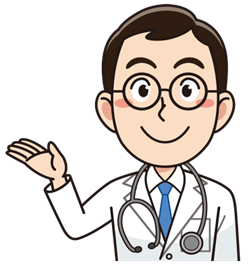ILC's Treatment for Myofascial Back Pain
Having been adopted in over 54 countries globally,
the "Cellgel Method" for treating lower back pain
is now available in Japan
For those who have been told it was impossible to operate,
For those who have had recurrence of pain post-surgery,
A low-risk, outpatient treatment is now an option for you.
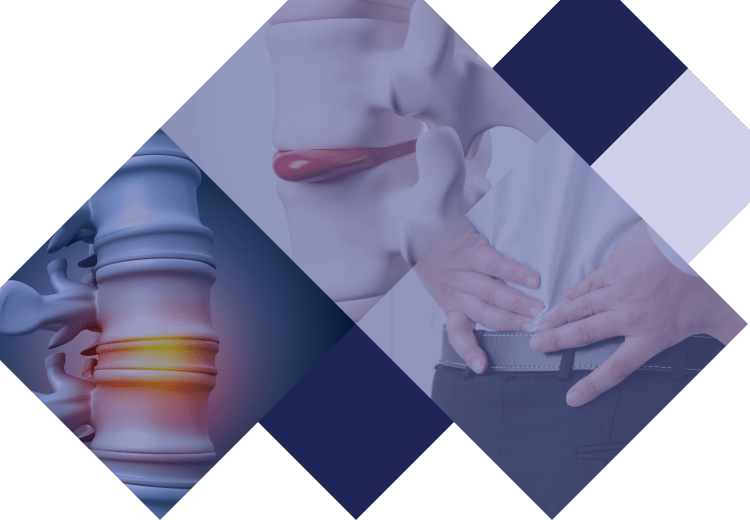
Contents
 Table of Contents
Table of Contents
This page provides information on the main symptoms and causes of myofascial back pain and our treatment procedures. The information includes the method of treatment, treatment time, and information about insurance. We use the Cellgel method, which is one of the most advanced methods in the world, and the characteristics of this method are also described in detail.
Please read this page especially if you have been told that you cannot be cured without surgery, if you have had surgery in the past but have not improved, or if you got better after surgery but the symptoms have recurred.
What is myofascial back pain?
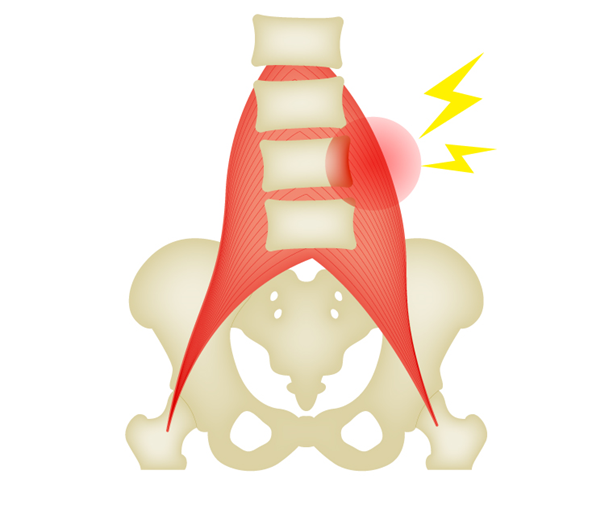
In the human body, there are "muscles" and the "fascia" that supports them.
The fascia refers to connective tissue that attaches, wraps, and/or separates the deep structures of the body. Fascia not only envelopes muscles, but also bones, internal organs, blood vessels, nerves, and many other organs, and supports the entire body by being properly positioned in each of these locations.
Fascia has a five-layer structure, and each of these layers is made to slide together. It has three main functions: 1. to protect muscles, 2. to help muscles exert force efficiently, and 3. to support blood vessels, nerves, and lymphatic vessels while simultaneously allowing them to pass through.
Myofascial back pain is a disease in which the muscles and fascia supporting the lower back and back become inflamed, causing pain.
Myofascial lower back pain is caused by sudden or chronic strain on the muscles and fascia of the lower back. It is characterized by the absence of abnormalities on x-rays and the absence of pain or numbness in the legs. It can be caused by chronic and continuous stress on the muscles and fascia due to poor posture or sudden stress on the lower back muscles due to heavy lifting or sports.
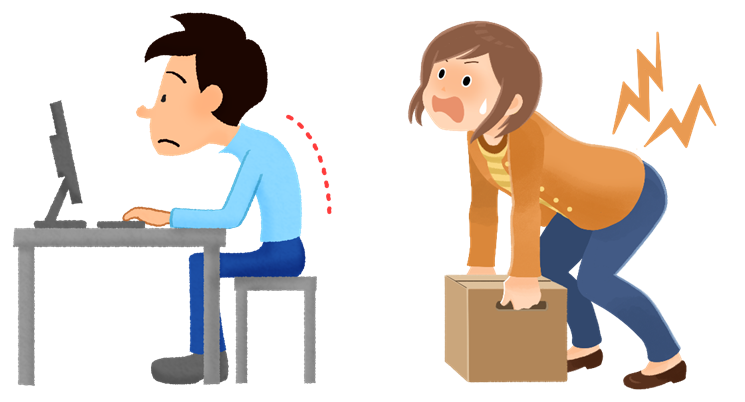
Main symptoms of myofascial back pain
Most cases of myofascial low back pain do not show abnormal findings on an X-ray or CT scan, but in acute onset cases, there may be findings on MRI that indicate muscle damage.
In most cases, tenderness and pain on movement are present along the lower back muscles. The extent of the pain itself and pain with movement is often ambiguous, though pain might be cause by certain movements, as in lumbar disc herniation or stenosis.
Pain is often caused by the following actions:
- Carrying heavy objects
- Changing posture after prolonged sitting or standing
- Working in a half-squat or bent position
- Sports that require a lot of twisting movements, such as golf
If the bad posture and movements that caused the symptoms are not corrected, the problems can easily become habitual, and the same symptoms may appear again with more pain.
The repetition of healing and recurrence of symptoms places a burden on the discs, vertebrae, and ligaments that support them. This burden is caused by lifestyle habits such as those described above, and the greater the strain, the greater the impact on the body.
Left unchecked, it can lead to:
- 1. Damaged intervertebral disc -> Damage or leaking of nucleus pulposus -> Intervertebral disc degeneration / lumbar disc herniation
- 2. Wear and tear of the disc and ligaments -> Strain on the surrounding tissues such as the vertebrae and joints -> Onset of intervertebral joint disorder
If you think you might experience of any of these symptoms, we recommend that you have them checked out instead of putting them off.
Causes of myofascial back pain
Myofascial back pain is often caused by inflammation resulting from the mechanism shown in the figure below, and is a symptom that tends to occur due to daily activities such as "long hours in the same position at a desk or driving a car" and "repetitive forward bending postures.
- 1. When muscles are overused, they become tense and stiff because they cannot withstand fatigue.
- 2. Stiffened muscles and fascia put pressure on blood vessels, resulting in deterioration of blood flow.
- 3. When the width and flow of blood vessels deteriorate, 'fatigue substances' accumulate.
- 4. When you move the body while the muscle and fascia are stiff and not smooth/warmed up, the accumulated fatigue substances turn into pain.
*Myofascia is considered to be more prone to pain than muscles because it has more nerves for pain than muscles.
Myofascial back pain may also occur secondary to complications such as disc degeneration or lumbar disc herniation.
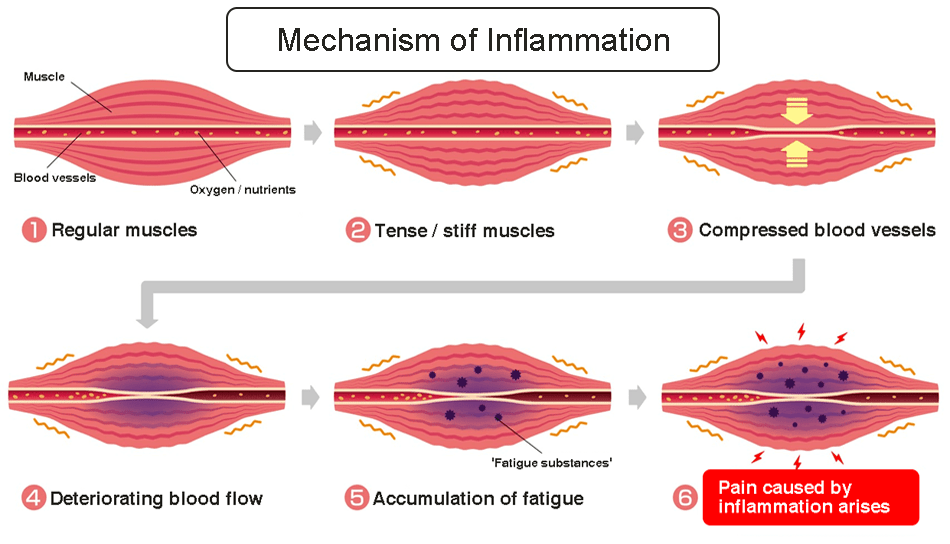
What are the effective treatments for myofascial back pain?
For myofascial low back pain, if the cause is presumed to be solely in the muscles or fascia, conservative therapy is used to monitor the condition. Conservative therapy includes medication, rehabilitation therapy, and nerve blocks. If conservative therapy does not improve the pain and the pain is prolonged, an x-ray or MRI scan will be performed to diagnose other causes. If imaging reveals disc deformity, misalignment or deformation of the spine, or inflammation of the intervertebral joints, alternative treatment will be necessary.
Surgical methods to reduce pressure on nerves are often used: spinal fusion, in which muscles and ligaments are removed and unstable bones are fixed with screws, or endoscopic surgery: shaving a portion of the lumbar spine and remove enlarged ligaments to remove the pressure. However, sometimes the inflammation does not subside and does not improve after surgery, or the pain recurs. Surgery not a fundamental treatment as the cause of the pain may not only be related to the spine or intervertebral disc, but also other factors such as body constitution, muscles, and ligaments.
With myofascial back pain, pressure on the nerves and worsening of symptoms are believed to be caused by deformation of the intervertebral discs. This is because the vertebral disc deformations cause the spine to become unstable, and to support them, the muscles and muscle membranes become excessively fatigued and painful. Therefore, we believe that if we can control the deformation of the disc, we can prevent pain and inflammation.
As a treatment for this, disc repair treatment using the Celgel method restores disc function by repairing the torn annulus fibrosus and replenishing the water content of the nucleus pulposus inside.
The treatment can be performed as a one-day procedure. Local anesthesia is given to the lower back, a needle is inserted into the disc, and a chemical solution is injected.
The treatment takes about 25 minutes and patients can go home after resting for about an hour.
Conventional Surgery
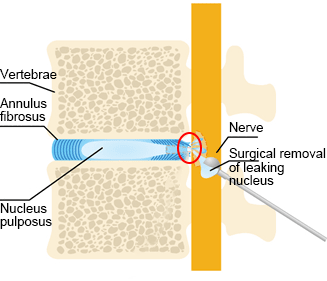
Only the protruding part of the disc is removed via endoscopic surgery.
The damage to the fibers is not repaired.
Cellgel Method
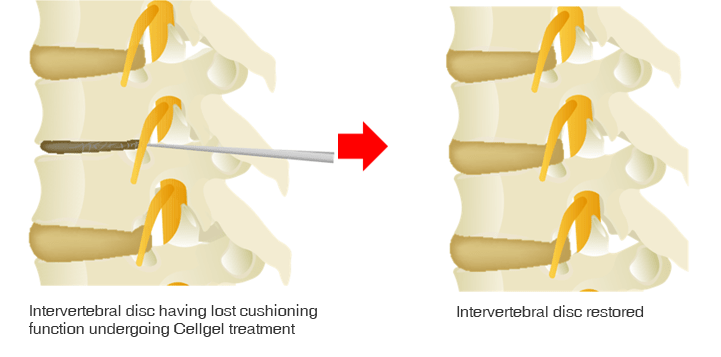
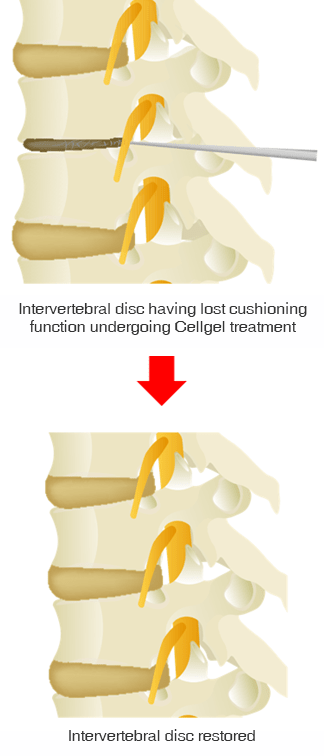
Since many of our patients come from far away,
we are happy to give free consultations to see which treatment is best for you
We'll diagnose your MRI images for free!
Treatment at ILC
There are four main treatments at our clinic.
As mentioned above, the root cause of each back pain disease is "inflammation and deformation due to aging of the intervertebral discs." Although the four treatment methods have different features and advantages, we would like to first introduce the "Cellgel method," which is the only one capable of intervertebral disc repair.
The Cellgel Method
About Cellgel
The Cellgel method is an advanced treatment for low back pain that has been implemented in more than 54 countries worldwide, predominantly in Europe.
As with other treatments, it does not decrease the disc volume, and since the drug remains in the disc as a gel-like implant after treatment, the disc can be preserved. Recent studies have also shown that the volume of the disc increases after treatment.*1
It is also thought that by repairing the disc and preventing leakage of the Nucleus Pulposus, the disc itself will restore its normal function with its own regenerative ability (*2).
It is particularly recommended for patients who are concerned about the risk of conventional disc surgery (MED, PELD, etc.).
*1 Source: European Journal of Radiology 109 (2018) 101–107 , Efficiency of an ethyl alcohol gel in symptomatic disc hernation
*2 Source: International Journal of Spine Surgery Vol. 15 Appendix 1 from regenerative treatment of disc degeneration
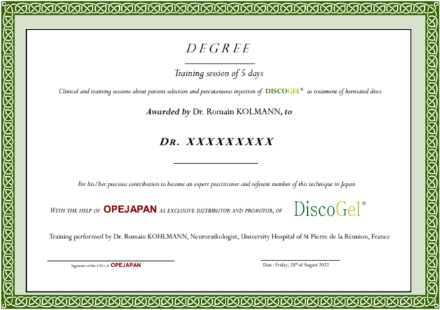
"Very good or good results were obtained in 202 (91.4%) of the 221 patients in group A. Of the 44 patients in group B, 37 patients (84%) presented very good or good results and in 9 (82%) of the 11 patients of group C, we obtained similar results. There was no allergic complication in any of our patients. Long-term follow-up magnetic resonance showed a dramatic reduction in hernia volume."
- Dr. J. Theron, one of the world's leading experts in the treatment of Celgel method, from his research article "Percutaneous Treatment of Lumbar Intervertebral Disk Hernias With Radiopaque Gelified Ethanol - A preliminary study."
Merits of Cellgel
- Possibility to repair intervertebral discs where unable to using surgical or laser treatment
- As the disc is repaired, the disc itself regains its original normal function through its own regenerative ability
- The Cellgel method uses local anesthesia over general anesthesia used in conventional surgery, making it less burdensome on the body
- Treatment is done with a thin needle, so the wound is minimal and recovery is rapid
- Treatment is very short, allowing for outpatient day treatment
- Safe, modern treatment proven in more than 54 countries around the world
Flow Cellgel Treatment Process
-
01 Examination
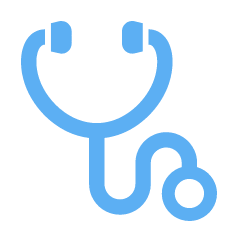
MRI and X-rays will be taken, followed by a doctor's diagnosis.
If the diagnosis proves the Cellgel method suitable, treatment can begin that same afternoon. -
02 Before
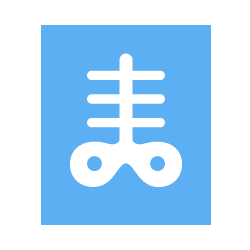
TreatmentAfter entering the treatment room and administering local anesthesia to the lower back, a needle is inserted into the intervertebral disc identified in the examination.
A contrast scan is performed to confirm the location of the damaged disc. -
03 Treatment
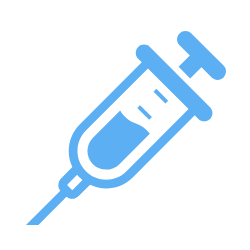
The Cellgel drug is administered to the damaged area while confirming the location of the disc with a fluoroscopy device.
Once the drug has been absorbed, the needle is removed and the bleeding is stopped.
-
04 Returning
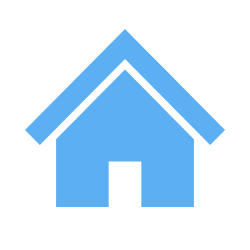
HomeAfter the treatment, the patient rests in a private room for about an hour, and then allowed to go home after the post-treatment examination.
*Resting time depends on the patient's symptoms and condition.
Price Cost of Treatment for the Cellgel Method
| Number of Discs Treated |
1 disc | 2 discs | 3 discs | 4 discs | 5 discs |
|---|---|---|---|---|---|
| Treatment Cost | 1,320,000 JPY | 1,430,000 JPY | 1,540,000 JPY | 1,650,000 JPY | 1,760,000 JPY |
Swipe left/righ
* The cost of treatment is indicated including taxes.
*If treatment is performed at our clinic, all examination/diagnosis costs and test costs such as MRI are included in the above costs.
*This treatment method is not covered by Japanese health insurance, so you will have to pay for the entire treatment yourself.
*Payment by credit card (VISA, MasterCard, JCB, American Express, Diners, Discover) is also possible.
*If you would like rehabilitation (low back pain specialized rehabilitation), it is also possible to pay by bank transfer.
*If you live and work in Japan, you can receive a tax refund by filing your final medical expense return.
FAQ FAQ about myofascial back pain and treatment
-
QWhat's the difference in the reccurence rate between Cellgel and conventional surgery?
-
A
Surgical procedures, which began in the 1960s, aimed to remove and sometimes fix deformed bones and herniated tissue. However, new bone damage caused by screws and the lack of fundamental treatment (repair of the intervertebral disc annulus fibrosus) resulted in the appearance of additional back pain and recurrence rates.
Therefore, in the 1980s, the need for fundamental treatment increased, and the intervertebral disc treatment (Cellgel) that we provide at our clinic began. Cellgel, in particular, have been proven to repair and regenerate the intervertebral disc, resulting in not only improvement of symptoms, but also an extremely low recurrence rate.
-
QHow is the disc to be treated determined?
-
AThe doctor will spend about 30 minutes with the patient while looking at the MRI and X-ray images to determine the cause of the condition, determine the treatment area, and explain the corresponding treatment method to the patient. MRI images show the main factors that contribute to back pain (disc, nerve, ligament, and joint), such as changes in shape, pressure on the nerve, presence or absence of damage, and inflammation. The x-ray image mainly confirms the condition of the bones.
-
QWhy is the Cellgel method applicable to cases where surgery showed no improvement?
-
ADuring surgery for disc herniation, the prolapsed herniation is removed, but the damaged disc remains intact. As a result, fresh nucleus pulposus components leak from the damaged disc and inflammation persists. On the other hand, our treatment can treat the disc injury itself, thus suppressing inflammation by reducing the fresh leakage of nucleus pulposus components.
-
QMy back pain may temporarily worsen after treatment. How long will it last?
-
AThe reason for the lower back pain is that spinal ligaments that have been compressed are stretched; the lower back pain lasts for about two weeks and then subsides.
-
QWhat level of exercise can I perform after treatment?
-
AGeneral recreational exercise and sports can be done without any problem. For professional athletes, the possibility of new disc damage is high and should be discussed in consultation with a doctor.
-
QPlease tell me about what I should be cautious about after treatment.
-
ADuring the first few days after treatment, the patient should rest and avoid prolonged sitting, heavy lifting, twisting, bending, or strenuous exercise. Patients should be able to perform routine tasks one week after treatment and should be able to perform light exercise by the second week. Weight training is allowed after 3 months.
-
QIs the treatment covered by the Japanese national health insurance?
-
ANo, it is not covered by the national insurance. If you have life insurance, you may be eligible. Please feel free to consult our staff regarding this matter.
-
QHow long must I wait to be able to walk after treatment?
-
AIt is an outpatient/day treatment, so you can walk about an hour after the surgery.
-
QHow many doctor visits do I need to make before treatment?
-
AWe require an MRI to be taken within three months for remote diagnosis, either with our affiliated clinic or from data sent by you. You can receive treatment on the same day after phyiscal diagnosis. You may also request only the diagnosis and come back only for the treatment at a later date.
-
QCan I fly immediately after the treatment?
-
AIf there are no problems after the treatment, you may fly. If there is any pain after the treatment, flying may not be recommended depending on the doctor's evaluation.
-
QWhat should I be cautious of when I have myofascial back pain?
-
AOnce you have been diagnosed with myofascial back pain, the first step is to prevent further disc and bone degeneration. If you perform a lot of back-straining activities or tasks, reduce the frequency of such movements, and listen carefully to your doctor's advice to determine what you should do next.
-
QCan myofascial back pain be cured without surgery?
-
A
In general, by taking care in daily life not to overburden or fatigue the muscles, the pain may be relieved. If the pain does not subside, we will treat it with conservative therapy (exercise therapy, heat therapy, medicine, and bracing), which is less stressful on the body.
However, if the pain is prolonged and does not resolve with conservative treatment, there is a possibility that another part of the body, such as the intervertebral disc or bone, is responsible for the pain. In such cases, the Cellgel method to repair the disc and the PODD method to suppress inflammation are required.
-
QCan I continue working if I have myofascial back pain?
-
A
It is possible to continue, depending on the severity of the symptoms.
However, if your job involves a lot of desk work or heavy labor, you need to refrain from such work as much as possible, as it is hard on the lower back.
If it is difficult to change your work environment, consider improving your physical condition, posture, and muscle strength. If these methods improve the condition, we recommend that you continue to use them.If there is no improvement, we recommend that you consult a doctor and receive a diagnosis.
-
QCan rehabilitation help me recover faster?
-
A
If there are no problems on the MRI scan, and if the problem is muscular or fascial, most patients will experience relief of inflammation and symptoms in about two weeks. Even in the case of chronic conditions, many people tend to improve after about two weeks of intensive rehabilitation.
Since many patients relapse due to their daily lifestyle and movement habits, correction of posture and movement is essential for a good outcome.
ILC Rehabilitation X Myofascial Back Pain Treatment
Although the Cellgel method can repair and regenerate the disc itself, and other treatment methods we offer can fundamentally heal the disc; it is possible that the cause of back pain is not only the disc, but also muscles, joints, and ligaments that are affected by the disc.
In cooperation with our rehabilitation specialists, we recommend treating back pain caused by muscles, joints, and ligaments together.
We also offer a short-term intensive program for patients who live far away or overseas.
-
ILC's Low Back Pain Treatment
Outpatient Treatment
Improve back pain disorders/
symptoms in relation to the nerves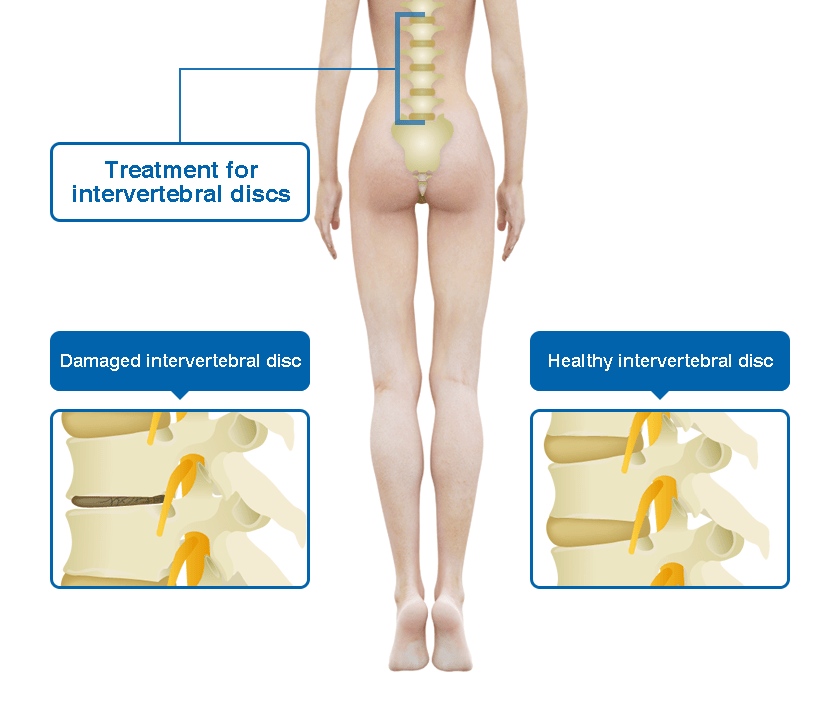
-
ILC's Rehabilitation Program
Specialized Low Back Pain Rehabilitation
Improve back pain disorders/symptoms in
relation to the joints, muscles, ligaments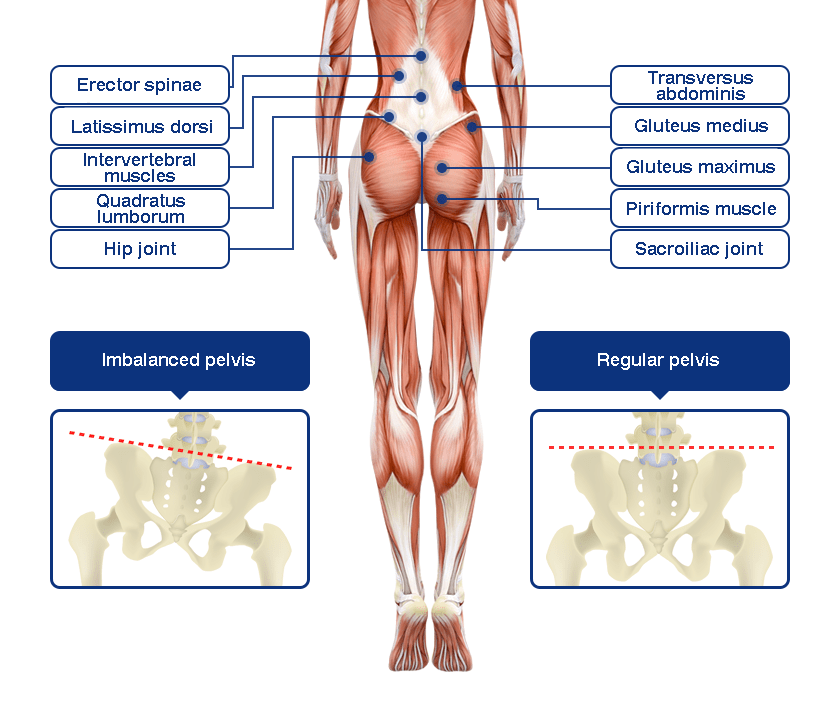
-
01
ILC's Specialized Back Pain Rehabilitation
Our Rehabilitation Approach to Myofascial Back Pain
Myofascial low back pain is caused by one's daily posture and movements, so it is important to find out what kind of posture and movements are causing the stress.
In rehabilitation, localized pain is first treated with acupuncture and manual rehabilitation to relieve pain. Massage for pain relief is effective to some extent, but the relief is temporary.Therefore, it is necessary to develop movements that do not place a burden on the patient while performing pain relief.
In addition, when stress is prolonged and inflammation is chronic, the patient is sensitive to pain, so even if stress is reduced by exercise, the localized chronic inflammation is difficult to mitigate.
In such cases, acupuncture, moxibustion therapy and diet therapy are used in combination to alleviate the inflammation as early as possible.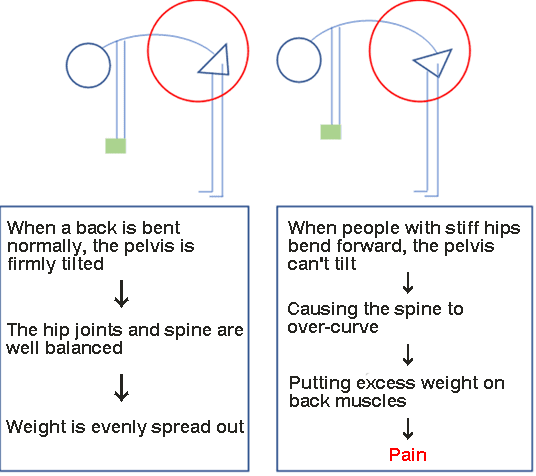
-
02
ILC's Specialized Back Pain Rehabilitation
How to Evaluate Myofascial Back Pain
Based on the MRI imaging findings, a consultation will be held with the doctor to determine if there are any findings of disc degeneration or spinal canal stenosis.
If there are no pathological findings on imaging, we will evaluate your posture and movements in daily life to find the cause of your pain.
If there are any abnormalities in posture or movement, we will evaluate the patient's physical condition, such as muscle strength and range of motion, while slowly moving the body to determine why the patient is using the body in such a manner.
If required, we will also perform a detailed evaluation using a Spinal Mouse.
-
03
ILC's Specialized Back Pain Rehabilitation
Rehabilitation Treatment for Myofascial Back Pain
The treatment method for myofascial low back pain differs depending on when and how it occurs, so each rehabilitation program is tailored to the symptoms.
In the case of an acute onset, inflammation is strong and the body cannot move as it should, so acupuncture is used to alleviate pain.
After the pain is relieved to some extent and the patient is able to move the body, we look at the posture, movement, muscles and fascia, etc. that caused the pain and try to restore them to their normal state to relieve pain and prevent recurrence.In the case of chronic onset of pain, which gradually increases, the patient has learned to move the body incorrectly in order to avoid pain.
Thus, it is necessary to distinguish the types of pain according to the type and length of the symptoms.[Main Treatment Details]
- 1. Correcting areas of excessive tension and imbalance
- 2. Correction of posture and movement
- 3. Pain relief
- 4. Improvement of blood flow
- 5. Guidance on lifestyle improvement
The above rehabilitation is performed with the aim of making the body less burdened than it was before.
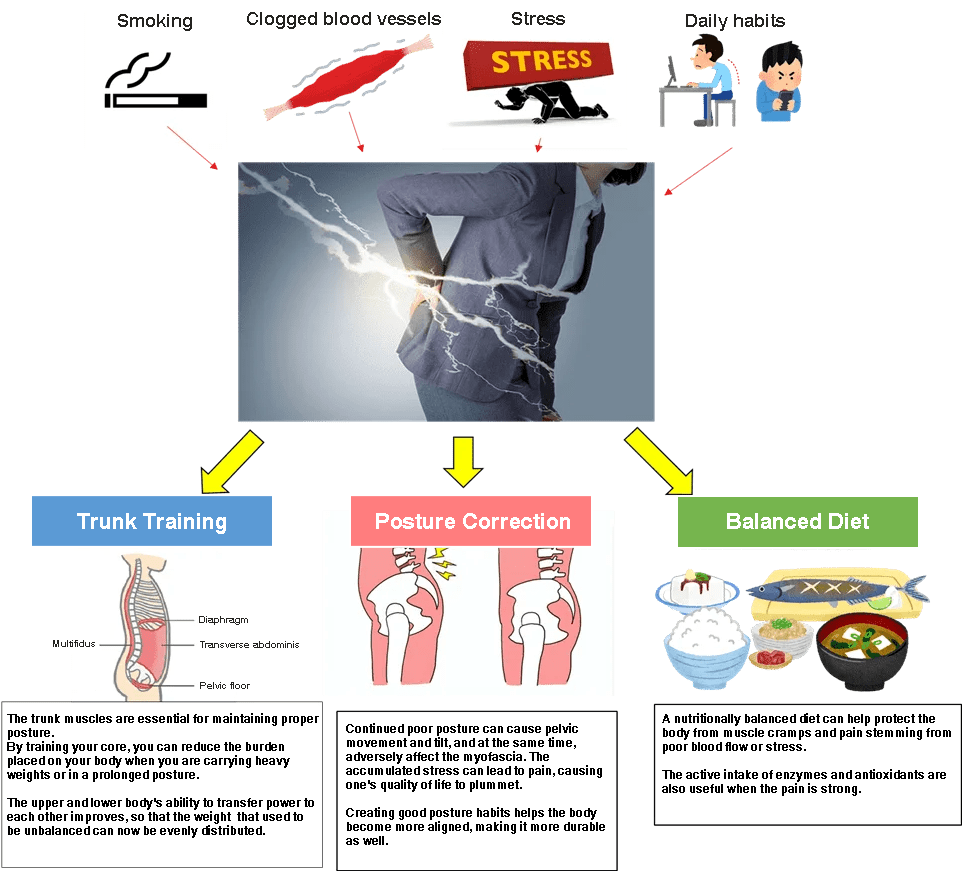
-
04
ILC's Specialized Back Pain Rehabilitation
Treatment Period for Myofascial Back Pain
For myofascial low back pain, the treatment period is shorter for younger patients with higher recovery capacity and longer for older patients, even if the symptoms are the same.
Acute low back pain may make it difficult to move around, and it may take up to three months for complete recovery in the case of a severely impacted condition.
Generally, if there are no problems on imaging and the problem is muscular or fascial, inflammation and symptoms are usually relieved in about two weeks.
Even in the case of chronic conditions, many people tend to improve after about two weeks of intensive rehabilitation.Since many patients relapse due to their daily lifestyle and movement habits, correction of posture and movement is essential for a good outcome.
We aim to achieve 100% effectiveness of treatment while incorporating the latest technology, so we spend at least 30 minutes with each patient to carefully and meticulously examine the patient's concerns in order to make a proper diagnosis and propose the most suitable treatment methods.
We are certain to find a way to alleviate or eliminate the pain and numbness you are experiencing, so please do not give up and give us a call instead!
- Tadaaki Minowa, Clinic Director
